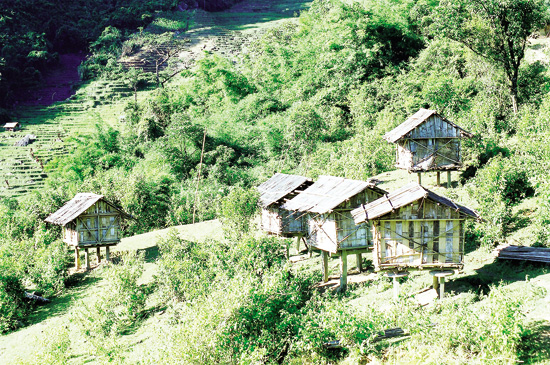
Vietnam Heritage, August-September 2011 — Several peoples in Vietnam’s Central Highlands build storehouses for food and seed. The rice storehouses of the Co Tu, Xo Dang and Gie-Trieng generally look the same. The floors are 1.5 m to 2 m by 2.5 m and 1.5 m to 2 m above the ground. The roofs are steep slopes that go down to the floor, which protects against moisture, insects and fires. The storehouses are usually on one or four supporting columns and built using mainly wood, bamboo, rattan and reeds. The floors are made of several woven bamboo layers and the walls of large sheets of woven sticks. A storehouse usually has one small door through which the stores go. There is a small ladder.
To avoid fires, the storehouses are always built right at the edge of the forest, far away from the villages. Though they are on the edge of the forest, their special architectural features stop wild animals getting in. To stop mice, umbrellas of wood with a diameter of 40 cm – 50 cm are fixed round the supporting columns, about 20 cm below the floor.
The Mnong, Ma and Xtieng build rice storehouses inside their houses. The longhouses that the Mnong tribes used to have contained five to ten households and each household had its own rice storehouse and kitchen. The insides of the longhouses were arranged according to a rule that the rice storehouse should be above the hearth and the bedrooms on the sides.
Not just houses that store grain but houses of the Rice God
The storehouses all have doors and ladders to make it easy to put rice in or get it out. When these storehouses are full, additional ones are built outside. The additional storehouses also must have a hearth under them and stoves are used regularly to produce smoke that prevents moisture and woodworm.
In addition to the rice storehouses, bamboo is woven to make containers for seed rice. On either side of a rice storehouse are big containers of seed rice and reserved eating rice.
Seeds of vegetables like loofahs, tomatoes, chillies, gourds and pumpkins are kept in sealed bamboo tubes placed above stoves so that they are dry and aren’t eaten by insects.
The Gia Rai have long storehouses for contributions from villagers after each crop. The contributed grain is for poor families when they haven’t harvested their crops or are in trouble.
The Co Tu have special rice farms and storehouses to support families in need. The farms are taken care of by the young men. After harvest, rice is taken to a common storehouse.
The ethnic minority peoples’ rice storehouses have entered poetry, legend and religion. They are depicted on clothes. The rice storehouse is where the Rice God resides. When rice is in the warehouses after a crop, the tribe always worships the soul of rice at the storehouse or storehouses.n
*Mr Tan Vinh is director of Quang Nam
Museum, in Quang Nam Province, in southern
Central Vietnam.

